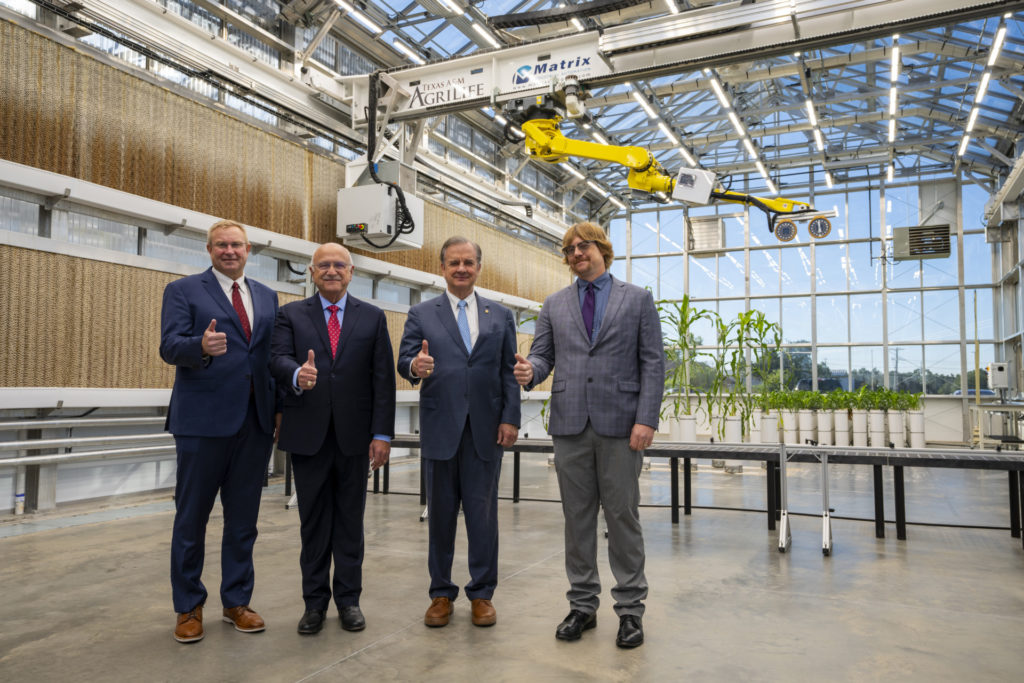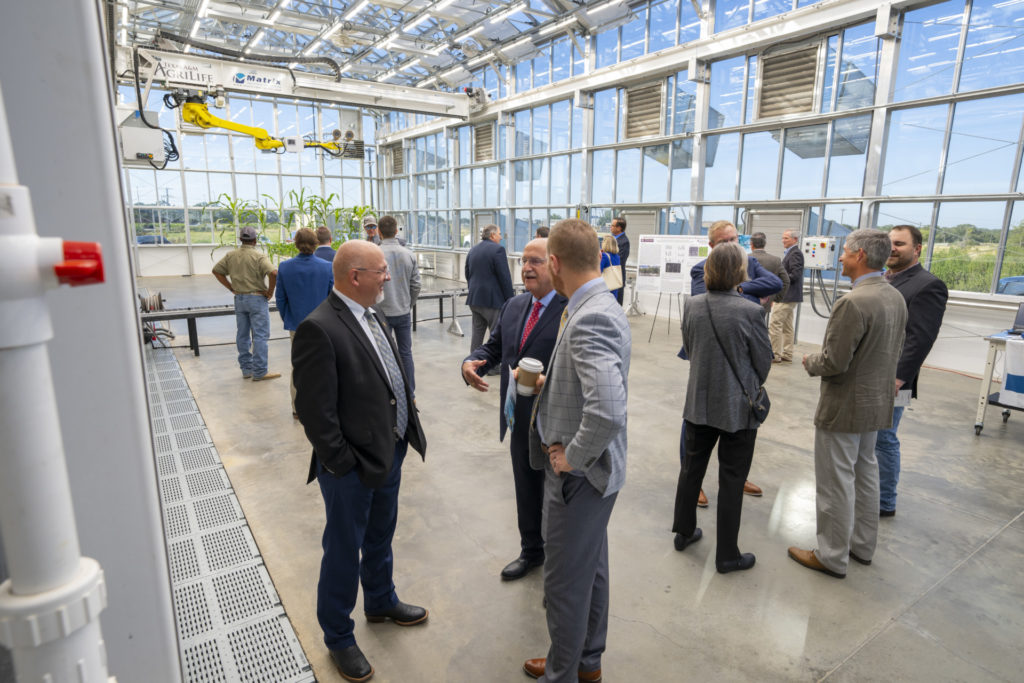College Station, Texas, USA
October 21, 2022
Featuring state-of-the-art robotics, remote sensing and data-capturing capabilities, Texas A&M AgriLife Research has launched “the future of agricultural research” with its multi-million dollar Automated Precision Phenotyping Greenhouse on the Texas A&M University campus in Bryan-College Station.
 (Left) Cliff Lamb, Ph.D., Texas A&M AgriLife Research director; Jeffrey W. Savell, Ph.D., vice chancellor and dean for Agriculture and Life Sciences; John Sharp, chancellor of The Texas A&M University System; and Seth Murray, Ph.D., Texas A&M AgriLife Research corn breeder and Eugene Butler Endowed Chair in the Department of Soil and Crop Sciences. (Texas A&M AgriLife photo by Michael Miller)
(Left) Cliff Lamb, Ph.D., Texas A&M AgriLife Research director; Jeffrey W. Savell, Ph.D., vice chancellor and dean for Agriculture and Life Sciences; John Sharp, chancellor of The Texas A&M University System; and Seth Murray, Ph.D., Texas A&M AgriLife Research corn breeder and Eugene Butler Endowed Chair in the Department of Soil and Crop Sciences. (Texas A&M AgriLife photo by Michael Miller)
The greenhouse is part of the Texas A&M AgriLife Plant Growth and Phenotyping Facility, which also includes the Borlaug Center for Southern Crop Improvement.
“The Automated Precision Phenotyping Greenhouse will serve our research enterprise in addressing new challenges and expectations of the food system,” said Cliff Lamb, AgriLife Research director, during a formal grand opening. “Our growing population will require a higher quality food system that prevents diet-related chronic disease, and whose smaller environmental footprint uses less water and fewer inputs – these are great challenges. The greenhouse will position us as a world leader in precision agriculture.”
With Texas enduring ongoing drought conditions, the research facility will allow scientists to explore breakthrough plant crop genomic discoveries to offset one of the nation’s most harsh growing environments.
In conjunction with advanced genomics and big data collection, the greenhouse technology can identify specific chemical compounds and accelerate crop plant improvements through breeding and genetics, maximizing productivity and stress tolerance.
Research initiative funding
Located at 3950 Finfeather Road in The Texas A&M Plant Growth and Phenotyping Facility, the greenhouse is funded by the Chancellor’s Research Initiative Award and matched by the Governor’s University Research Initiative Award. Additional robotic equipment is funded by a Research Development Fund Award. The facility had a construction budget estimated at $3.5 million.
 Located at 3950 Finfeather Road in The Texas A&M Plant Growth and Phenotyping Facility, the greenhouse is funded by the Chancellor’s Research Initiative Award and matched by the Governor’s University Research Initiative Award. Additional robotic equipment is funded by a Research Development Fund Award. The facility had a construction budget estimated at $3.5 million. (Texas A&M AgriLife photo by Michael Miller)
Located at 3950 Finfeather Road in The Texas A&M Plant Growth and Phenotyping Facility, the greenhouse is funded by the Chancellor’s Research Initiative Award and matched by the Governor’s University Research Initiative Award. Additional robotic equipment is funded by a Research Development Fund Award. The facility had a construction budget estimated at $3.5 million. (Texas A&M AgriLife photo by Michael Miller)
The facility features two greenhouses with robotic gantry systems, one 2,400 square feet and the other 600 square feet. Their gantry systems transmit the entire length of each greenhouse. On the gantry systems are rolling trucks with long-reaching robotic arms to perform various research activities such as monitoring plant health and movement. A sensor head includes a multispectral camera and a Raman spectrometer.
The greenhouse facility also includes three additional 600-square-foot research greenhouses without robotic systems. All five greenhouses feature advanced LED lighting systems and eaves that are 19 feet high. Lab and field researchers can also access a 1,500-square-foot headhouse equipped with autoclaves and potting tables, as well as a laser room and common-use laboratory.
‘Milestone for Texas A&M AgriLife’
“This is an important milestone for Texas A&M AgriLife Research, Texas A&M AgriLife and The Texas A&M University System as we continue to innovate and meet new challenges in providing solutions for Texas agriculture and abroad,” said Jeffrey W. Savell, Ph.D., vice chancellor and dean for Agriculture and Life Sciences.
The facility provides Texas A&M faculty with a unique infrastructure for automated precision phenotyping, significantly accelerating crop improvement progress and allowing iterative cycles of optimization and calibration.
“It will also be a platform for interdisciplinary research where physicists, biochemists and engineers will work alongside field scientists in soil, plants, microbes, insects and other interrelated disciplines,” Lamb said.
The new technology will help advance urban and traditional field-based row agriculture, he noted.
“Researchers can replicate environments that occur naturally in the field. State-of-the-art technology will allow traits to be measured autonomously with extreme precision using robots and sensors.”
Lamb said the facility will also help recruit leading graduate students.
“These future scientists will learn the latest skills and technologies needed to characterize plant and stressor interactions and work hand in hand with producers and consumers,” he said. “The greenhouse facility will aid faculty in attracting top graduate school candidates and additional federal and industry funding in these areas.”